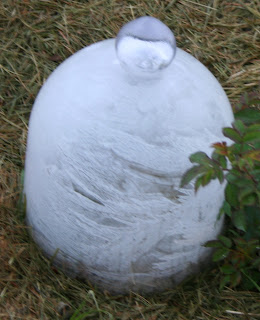But I will take advantage of the lousy weather and lack of decent rose pictures to slip a little gardening tip into the blog. I've written previously about obtaining some nice glass cloches last January that I was, and am now, immensely proud of. They served me well through a frigid winter and a cold and unpredictable Spring here in Kansas until a few weeks ago, when the weather hit the 80's. I found then that some of the new roses were getting a little bit "burnt" in them. And no wonder, because I found later that a clear glass cloche in my garden, at an ambient air temperature of 81F on noon of a clear sunny day, has an interior temperature, measured by my soil thermometer, of 140F! Time for the cloches to come off, but the weather has been so variable, and with night temperatures reaching into the 40's, that I really didn't want to keep them off, nor did I want to be running around every day and night covering and uncovering them.
So, when the rose leaves began to fry a little, I got it into my head that I could whitewash the cloches, just like K-State does its glass greenhouses. I did a quick search around town for some plain old whitewash, thinking that a little "shading" would improve the problem, and came up empty. So I turned to the Internet, the modern Tree of Knowledge of Good and Evil, and came up with a simply made whitewash formula. After coating the interior of the cloches with my homemade whitewash, as shown above, the interior temperature on the same sunny day was only 98F, a vast improvement and survivable by the roses, particularly during weeks like this, where the high temperatures have been in the 70's recently, the nights in the 50's, and it has rained for days.
Remember fellow gardeners, cloches are just mobile greenhouses and whitewash does wonders for the plants under the glass. The formula, cut down to a small, manageable amount, is below:
3 parts hydrated lime
1 part salt8 parts water
If you substitute the word "cups" for "parts" above, it will make about a half-gallon of whitewash, which goes a long way, so you can cut it down if you need less (that's why I converted the recipe to "parts"). Be careful to mix in small amounts of each ingredient slowly, so that the powdery lime doesn't just clump up and become hard to stir. It was recommended to let it sit overnight, but I used it immediately and it seemed to work well. It's fairly watery when mixed, but remember it is a wash, not a paint. I did use a paintbrush to slop it on the interior of the glass, though. So nice to "paint" and not worry about how much I drip on the ground!






